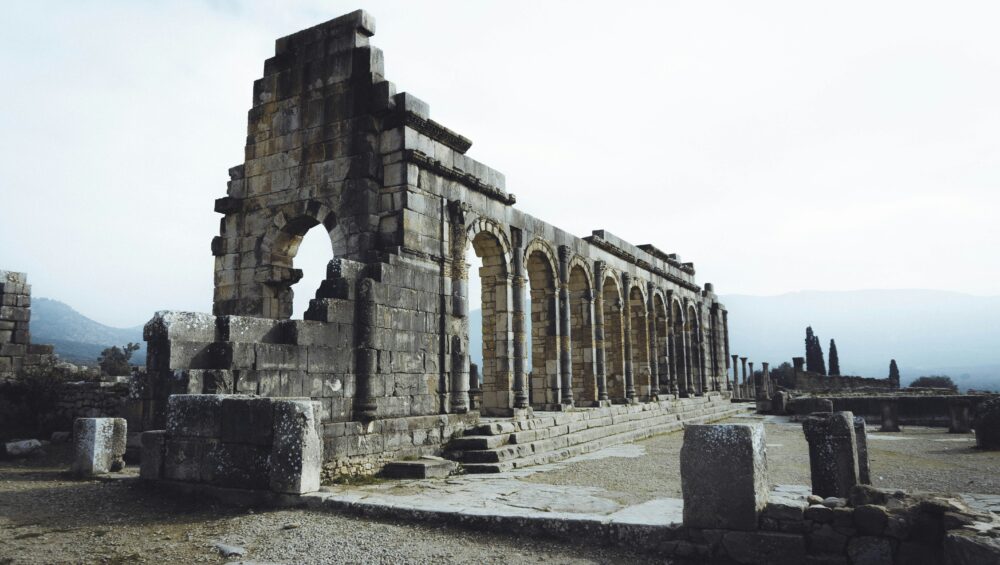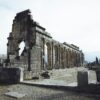Ancient Morocco: Insights into the Moroccan Empire
Welcome to a journey back in time to explore the grandeur and significance of the Moroccan Empire. Situated in North Africa, the empire holds a vital place in history, shaping the region’s cultural, political, and economic landscape. From its humble beginnings to its golden age of prosperity, the empire of Morocco left an indelible mark on ancient Morocco. Join us as we delve into its rise, achievements, decline, and lasting legacy.
Key Takeaways:
- The Moroccan Empire played a crucial role in shaping the history and identity of ancient Morocco.
- Known for its grandeur and significance, the empire emerged as a prominent power in North Africa.
- The golden age of the Moroccan Empire was marked by remarkable achievements in art, architecture, science, and trade.
- Facing internal conflicts and external pressures, the empire eventually experienced a decline.
- The heritage of the Empire of Morocco continues to impact modern-day Morocco.
The Rise of the Moroccan Empire
The Moroccan Empire, also known as the empire of Morocco, was a significant power in ancient Morocco, with a rich history that shaped the region’s identity. This section will delve into the early years of the empire, tracing its origins and discussing the factors that led to its rise.
The Empire Morocco began its ascent in the 8th century AD when the indigenous Berber tribes united under the Idrisid dynasty. With their strong leadership and military prowess, the Idrisids expanded their territories, establishing their capital city in Fes and laying the foundation for the empire’s future growth.
Under the reign of the Almoravids in the 11th century, the Moroccan Empire experienced a period of rapid expansion. Led by their charismatic leader Yusuf ibn Tashfin, the Almoravids conquered vast regions of North Africa and Spain, extending their influence across the Mediterranean and further solidifying Morocco’s position as a prominent power.
“The rise of the Moroccan Empire marked a turning point in the region’s history. Its conquests, military might, and strategic alliances allowed for the emergence of a prosperous and culturally diverse empire.”
Trade played a crucial role in the rise of the Moroccan Empire. The empire’s location along major trade routes, connecting West Africa to Europe and the Middle East, facilitated the exchange of goods and ideas. The empire prospered through the trade of gold, salt, spices, textiles, and other valuable commodities, fueling its economic growth and enhancing its influence.
The Moroccan Empire’s rise also owed much to the contributions of Islamic scholars and intellectuals who flourished during this era. The empire became a center of learning and scholarship, attracting renowned thinkers, philosophers, and artists from around the world. This intellectual environment fostered a flowering of art, architecture, and science, contributing to the empire’s cultural and academic achievements.
By the 13th century, the Marinid dynasty came to power and continued the expansion and consolidation of theEmpire of Morocco. The Marinids established a new capital in Fes, known for its stunning architecture and vibrant cultural scene. They further expanded the empire’s territories, reaching their zenith of power during the 14th century.
In conclusion, the rise of the Moroccan Empire was marked by a combination of strategic alliances, military conquests, and vibrant trade networks. Through the expansion of its territories and the establishment of dynasties, the empire emerged as a significant power in North Africa. In the next section, we will explore the golden age of the Moroccan Empire, where its cultural and intellectual achievements reached new heights.
The Golden Age of the Moroccan Empire
The Moroccan Empire reached its pinnacle of power and prosperity during the Golden Age, leaving a lasting impact on the history of ancient Morocco. This era witnessed remarkable achievements in various fields, showcasing the cultural richness and influence of the empire.
Cultural Renaissance
Art and architecture flourished under the Moroccan Empire, with monumental structures and intricate designs adorning cities and palaces. The empire’s grand mosques, such as the stunning Koutoubia Mosque in Marrakech. Exemplify the exquisite craftsmanship and architectural brilliance of the time. Additionally, vibrant mosaics, calligraphy, and ornate geometric patterns adorned palaces and public spaces, reflecting the cultural fusion of Arab, Berber, and Andalusian influences.
The empire also nurtured a thriving intellectual and scientific community. Scholars, philosophers, and mathematicians made significant contributions, advancing knowledge in areas such as astronomy, medicine, and philosophy. Notably, the royal library in Fez, known as the Qarawiyyin Library, stands as a testament to the empire’s commitment to education and intellectual pursuits, dating back to the 9th century.
Trade and Commerce
The Moroccan Empire established itself as a key player in trade and commerce, benefiting from its strategic location as a gateway between Africa, Europe, and the Middle East. The empire fostered strong diplomatic relations with other nations, securing lucrative trade routes and flourishing commercial exchanges. Ancient Moroccan cities like Fez, Marrakech, and Tangier became bustling centers of trade, attracting merchants from around the world.
The empire’s access to valuable resources, such as gold, salt, and spices, further fueled its economic prosperity. Moroccan merchants were renowned for their expertise in trade, making significant contributions to the growth of international commerce during this period.
Influence and Legacy
“The Moroccan Empire’s Golden Age represented a thriving civilization that left an indelible mark on the cultural, intellectual, and economic landscape of ancient Morocco.” – Historian, Dr. Hamid Ait Hmid
The cultural achievements and economic prowess of the Moroccan Empire during its Golden Age continue to shape the identity of modern-day Morocco. The empire’s influence can be seen in the country’s vibrant arts and crafts, distinct architectural styles, and rich culinary traditions. Additionally, the empire’s legacy extends beyond Morocco’s borders, influencing the diverse cultures of North Africa and beyond.
As we explore the Golden Age of the Moroccan Empire, we gain insight into a period of remarkable cultural brilliance and economic prosperity, enhancing our understanding of ancient Morocco and its enduring historical significance.
Decline and Legacy
The Moroccan Empire, once a mighty force in the region. Faced various challenges that contributed to its decline and eventual downfall. External pressures, internal conflicts, and shifting dynamics within the region played significant roles in shaping the empire’s destiny.
The empire of Morocco encountered formidable foes, such as the Ottoman Empire and European colonial powers, who sought to gain control over its rich resources and strategic location. These external pressures strained the empire’s resources and weakened its military defenses, leaving it vulnerable to incursions and territorial losses.
Internal conflicts also plagued the Moroccan Empire during its later years. Power struggles within royal families and rival factions led to instability and weakened the centralized authority of the empire. These internal divisions further undermined the empire’s ability to resist external threats and maintain control over its territories.
“The decline of the Moroccan Empire was a result of a complex mix of external pressures, internal conflicts, and changing dynamics within the region. These factors gradually eroded the empire’s power and paved the way for its ultimate downfall.”
Additionally, the Moroccan Empire had to contend with changing dynamics within the region. As the global balance of power shifted and new trade routes emerged, the empire faced challenges in adapting to these changing circumstances. The rise of European maritime trade routes bypassing North Africa posed a significant threat to Morocco’s trade and economic prosperity.
Despite its decline, the Moroccan Empire left a lasting legacy on modern-day Morocco. The empire’s rich cultural heritage, architectural marvels, and artistic contributions continue to shape the country’s identity. Ancient Morocco’s influence can be seen in the magnificent palaces, historical sites, and vibrant traditions that have been preserved and celebrated over the centuries.
The legacy of the Moroccan Empire serves as a reminder of the grandeur and splendor that once characterized ancient Morocco. It stands as a testament to the resilience and enduring spirit of the Moroccan people, who carry forward the rich traditions and historical significance of their ancestors.
Conclusion
Ancient Morocco, with its rich historical heritage, has been greatly shaped by the mighty Moroccan Empire. This empire, once a formidable power in North Africa, left an indelible mark on the region’s history and identity.
Throughout this article, we have explored the rise, golden age, decline, and lasting legacy of the Moroccan Empire. From its humble beginnings, the empire expanded its territories, established influential dynasties, and reached its pinnacle of power during the golden age.
During this golden age, Morocco flourished with remarkable achievements in art, architecture, science, and trade. The empire’s cultural richness and influence extended far beyond its borders, leaving a lasting impact on the development of ancient Morocco.
While the Moroccan Empire eventually faced challenges and experienced decline. Its legacy continues to shape the historical narrative of ancient Morocco. The empire serves as a testament to the enduring spirit and resilience of the Moroccan people. Fostering a sense of pride and appreciation for their historical roots.
FAQs
What was the Moroccan Empire?
The Moroccan Empire, also known as the empire of Morocco, was a powerful and influential empire in North Africa during ancient times.
What is the significance of the Moroccan Empire?
The Moroccan Empire played a crucial role in shaping the history and culture of ancient Morocco. It was known for its grandeur, accomplishments, and lasting legacy.
When did the Moroccan Empire rise to power?
The Moroccan Empire had its beginnings in the early years and experienced a period of rapid expansion. Establishing dynasties and becoming a prominent force in the region.
What were some key achievements of the Moroccan Empire?
The Moroccan Empire enjoyed a golden age of prosperity and power, with notable achievements in art, architecture, science, and trade. It left a profound cultural impact on the region.
How did the Moroccan Empire decline?
The Moroccan Empire faced various challenges, including external pressures, internal conflicts, and changing dynamics. These factors led to its decline and eventual downfall.
What is the legacy of the Moroccan Empire?
Despite its decline, the Moroccan Empire left a lasting legacy on modern-day Morocco. It shaped the country’s history, identity, and cultural heritage.
What can we learn from the Moroccan Empire?
The Moroccan Empire provides valuable insights into the importance of historical empires and their impact on shaping societies. It also highlights the rise and fall of powerful civilizations.




